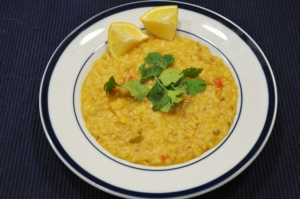 Summer is officially here. Highs for the past few days have jumped rather precipitously to the upper 80s and low 90s. Seasonal transitions seem to be times of vulnerability, at least for my body. While on one hand, I’m craving cool, raw foods, especially as my lettuce gets closer to harvesting every day. On the other hand, I’m also craving something easy to digest.
Summer is officially here. Highs for the past few days have jumped rather precipitously to the upper 80s and low 90s. Seasonal transitions seem to be times of vulnerability, at least for my body. While on one hand, I’m craving cool, raw foods, especially as my lettuce gets closer to harvesting every day. On the other hand, I’m also craving something easy to digest.
My go-to when my digestive system needs calming is kichari (a.k.a. kichadi or kitchari). Kichari is a stew with a base of proteins, carbohydrates, veggies and herbs. In Ayurveda, where kichari is a staple food, the specific proteins, carbs, veggies and herbs we choose depends on which specific organ system or Ayurvedic constitution we want to support.
If you look online you can find kicharis that support the various Ayurvedic constitutions as well as those that regulate metabolism, aid digestion, detox the liver or cleanse the blood.
Most recipes start with white basmati rice and mung dal (split mung beans). From there the variations are endless. If you can’t find organic mung dal locally, here’s a site where you can buy it. For most recipes, I prefer to use brown basmati rice because of the added nutrients, but white basmati is easier to digest, so it works better in kichari.
The kichari I ate for the past few days is very basic and not at all spicy, despite the optional hot chile. Consuming your kitchari in a quiet, calming environment can increase the benefits by supporting healthy assimilation.
You might follow with a Restorative pose that aids digestion. Supta Baddhakonasana is a great choice. It’s one of the few yoga poses that are not only okay, but helpful to practice after eating.
Basic Kichari
- 1 t ghee (you can find organic ghee at most natural foods stores)
- 1 t cumin seeds
- 1/2 c finely chopped onion
- 1 T fresh ginger, minced
- 1 jalapeño or serrano chile, seeds removed and chopped fine (optional)
- 1 c chopped tomato
- 1/4 t Garam Masala (you can find this already mixed at natural food stores or Indian groceries, or you can make your own)
- 3/4 c mung dal, rinsed and soaked for 30 minutes
- 3/4 c white basmati rice, rinsed and soaked for 30 minutes
- 4 cups water
- 1 t salt
- 1 lemon, cut in quarters, for garnish
- cilantro, for garnish
- Heat the ghee in a soup pot over medium heat. When it is hot, add the cumin seeds and cook, stirring, for about one minute. When you start to smell the fragrance of cumin you can go to the next step.
- Add the onion and cook until translucent, 5-7 minutes.
- Add the ginger and chile, and cook for one minute. Stir in the tomatoes and remaining spices and cook for about 5 minutes.
- Add the lentils and rice along with the water and salt. Cover, bring to a boil and simmer for about 20 minutes, until the rice and mung dal are tender.
- Serve warm with lemon juice and fresh cilantro.
